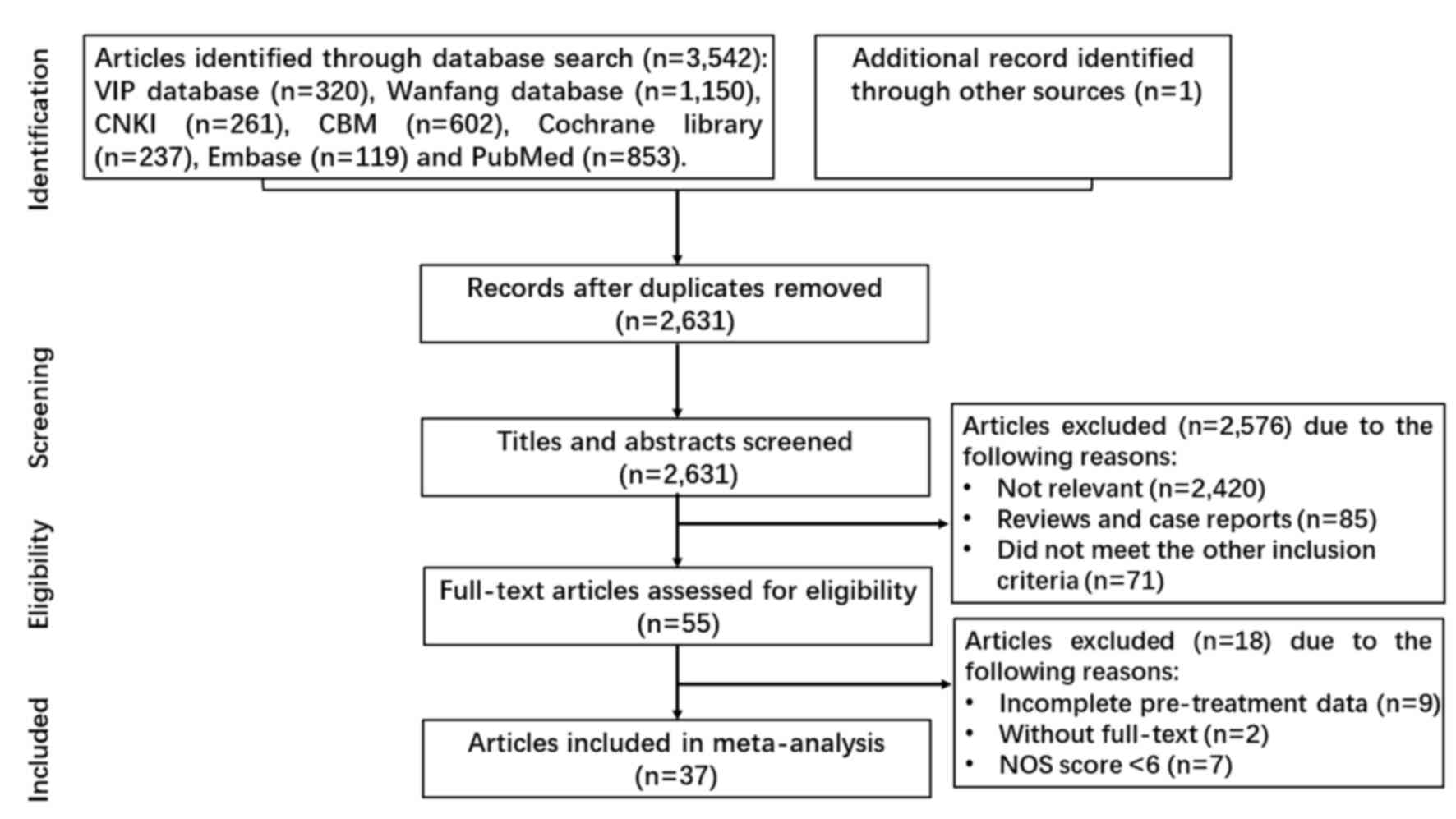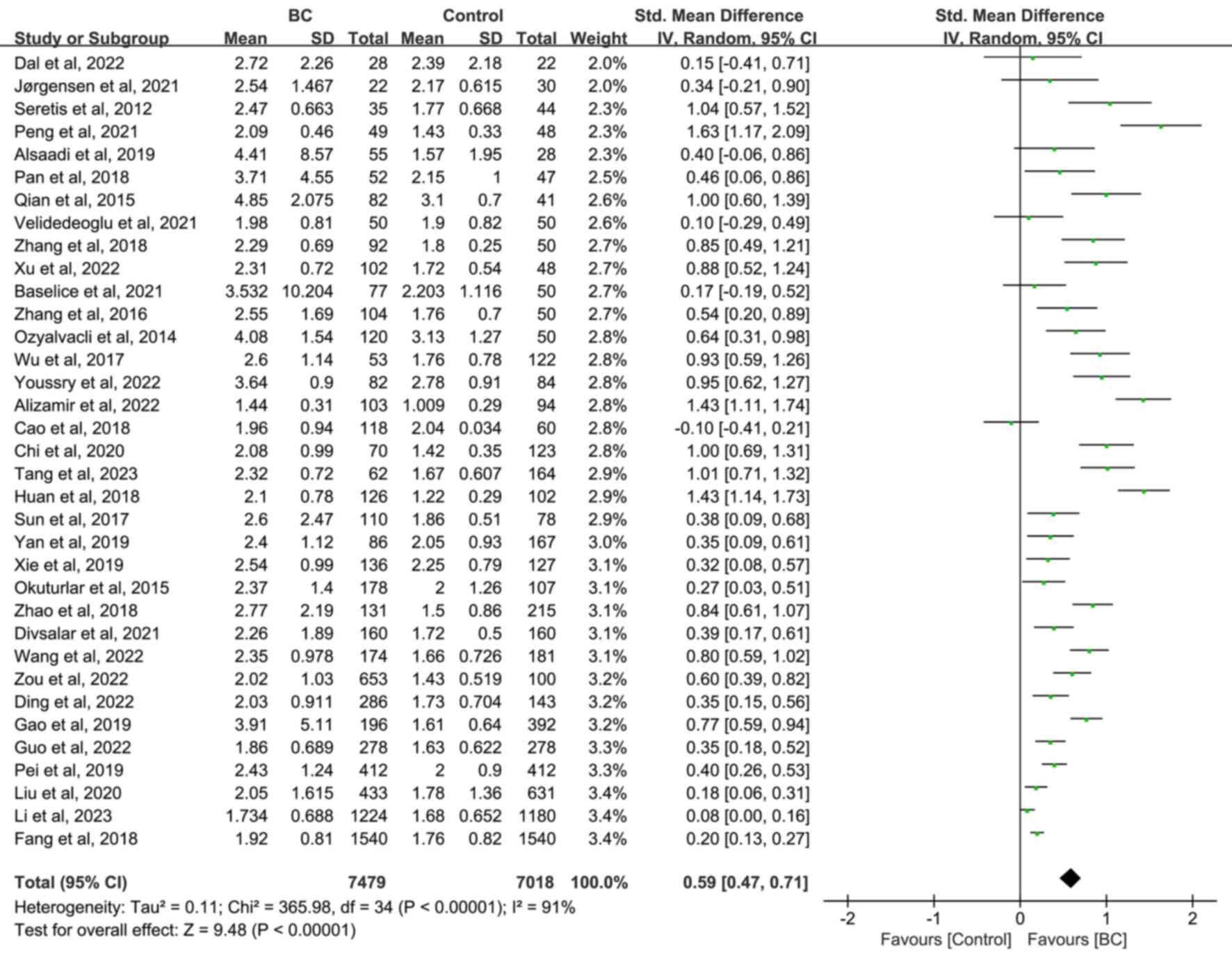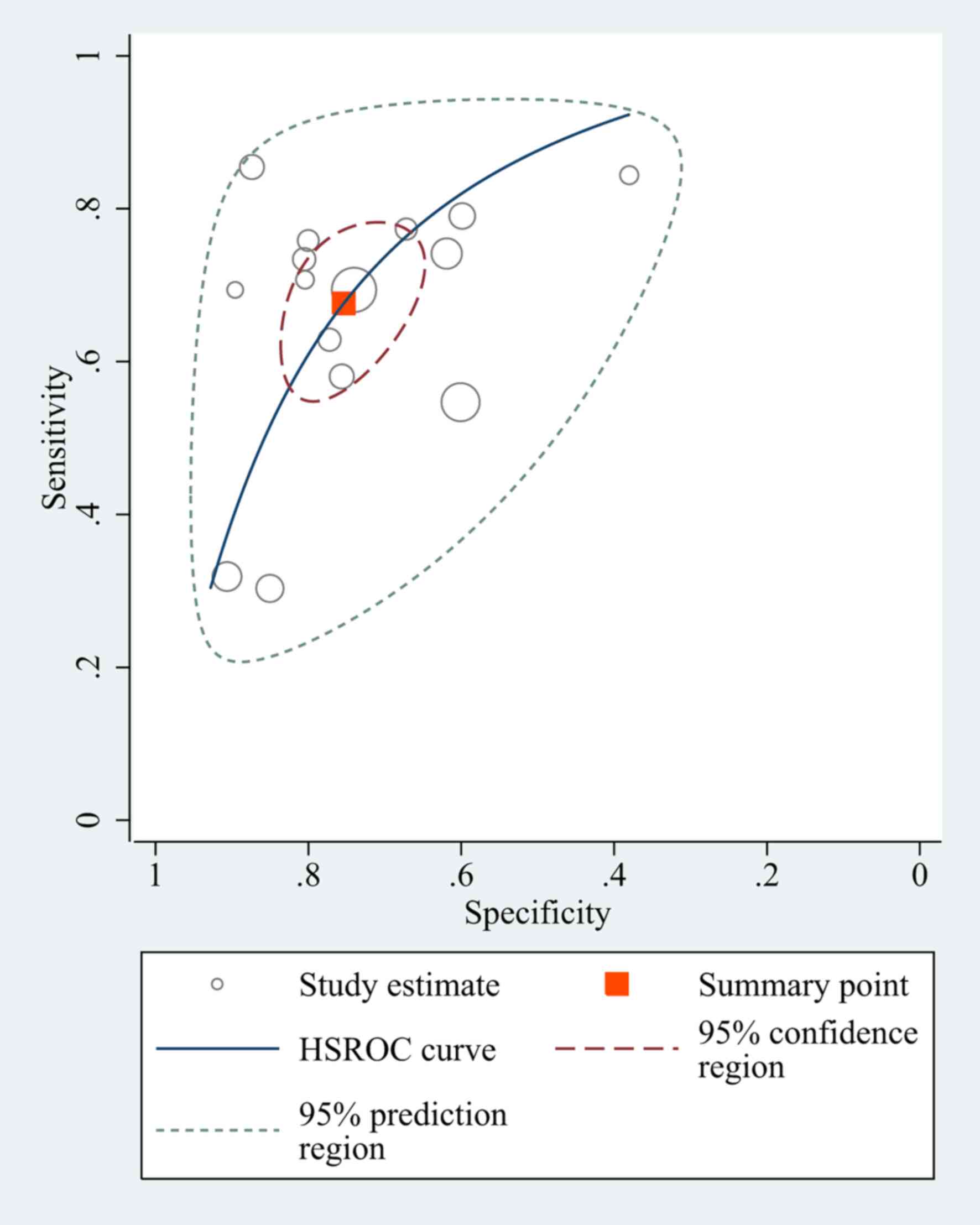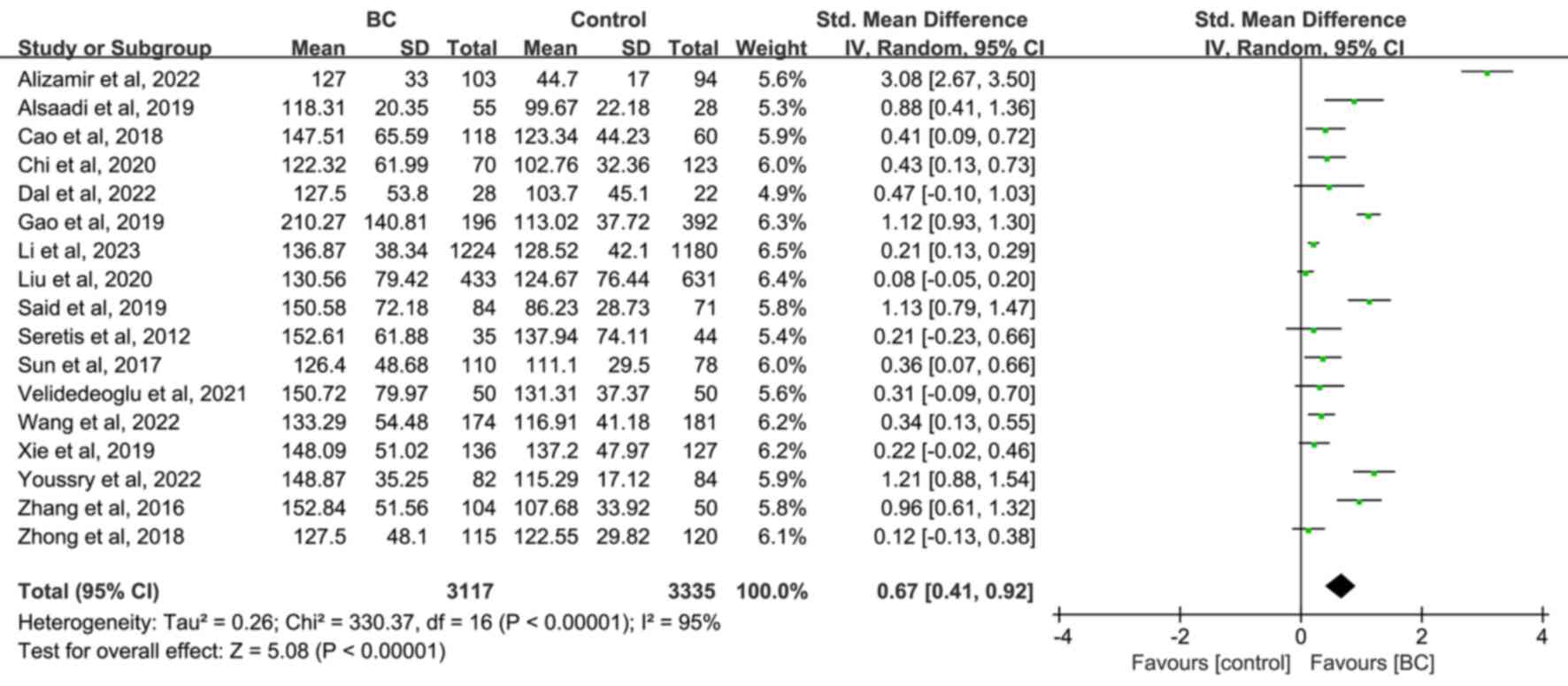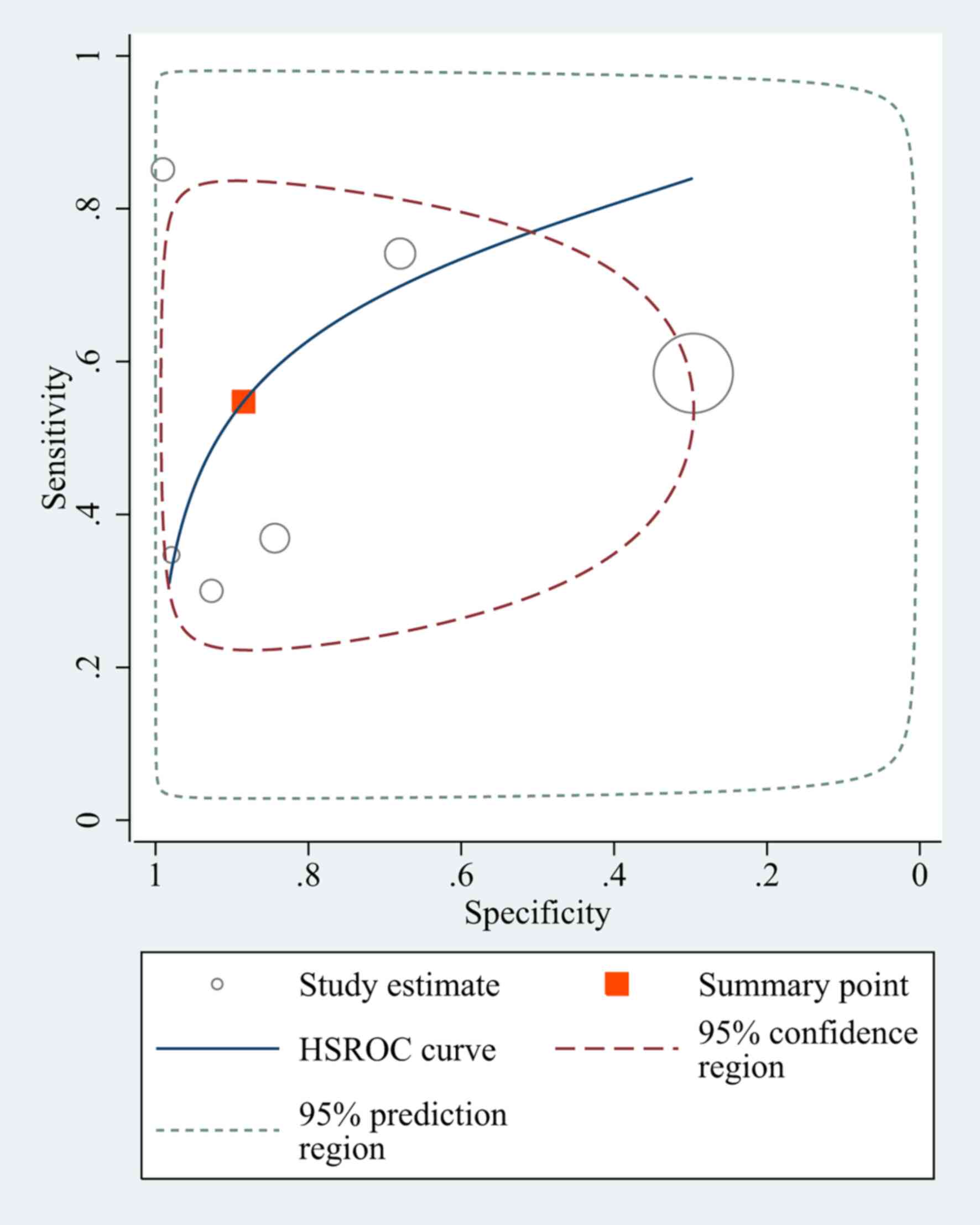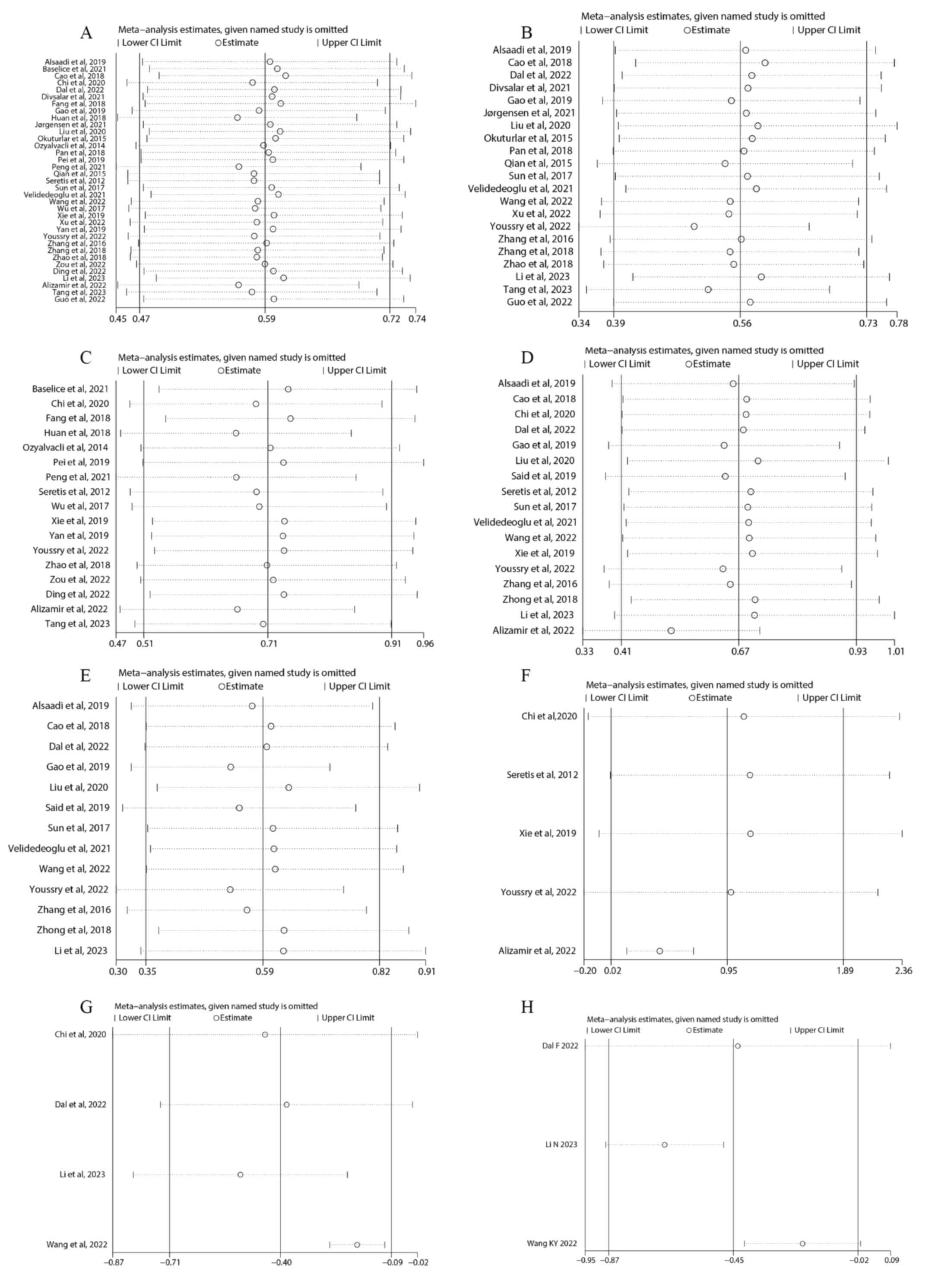Diagnostic role of the neutrophil‑to‑lymphocyte ratio and the platelet‑to‑lymphocyte ratio in breast cancer: A systematic review and meta‑analysis
- Authors:
- Published online on: November 4, 2024 https://doi.org/10.3892/ol.2024.14787
- Article Number: 41
-
Copyright: © Yang et al. This is an open access article distributed under the terms of Creative Commons Attribution License.
Abstract
Introduction
Breast cancer (BC) is one of the most common malignancies affecting the health of women worldwide with an estimated 2.3 million new cases and 685,000 deaths in 2020. It is also the leading cause of cancer-related death in women (1). Early screening and diagnosis of BC has positive impacts on treatment outcomes and the psychology of the patient as well as decreasing the economic burden of this cancer (2). Widespread BC screening in the USA and other high-income countries has contributed to a decreased number of mortalities from BC in these populations over recent decades (3). It has also helped to identify contraindications to medication, e.g. BC is a contraindication for estrogen plus progestogen (4). However, there are ethical challenges and economic and demographic differences that hinder early screening in underdeveloped countries and regions, which, for example, makes it difficult to systematically implement BC screening in sub-Saharan Africa (5). Furthermore, the contradiction between a large population and limited resources poses a huge challenge for China to increase the national coverage of BC screening (3). For BC, breast self-examination (BSE) and clinical breast examination (CBE) can catch the first physical changes in the breasts and, subsequently, a mammography should be performed (6). However, in resource-limited settings, a mammography is assessed as not cost-effective (5). In addition, current research does not indicate that there is an improved detection and diagnosis rate of early BC using BSE and CBE (5,6). In recent decades, the serum concentration of tumor markers has been used to detect tumor activity, as suggested by the updated recommendations of the American Society of Clinical Oncology (7). Tumor markers are minimally invasive, readily available and low-cost, providing an alternative approach to BC screening (7,8). However, the efficacy of mainstream clinical tumor markers has been questioned due to their low diagnostic sensitivity of the disease at early stages, such as carcinoembryonic antigen (7). Thus, there is a need for affordable, accurate and sensitive markers for the monitoring of BC. Research on potential tumor markers may be of significance for the screening of BC, especially in low- and middle-income countries (9).
Cancer development is, among other factors, driven by a tumor-mediated disorder of immunity, along with immune disorders in all cell populations (10). There is evidence suggesting that the neutrophil-to-lymphocyte ratio (NLR), platelet-to-lymphocyte ratio (PLR) and lymphocyte-to-monocyte ratio (LMR), among those derived from peripheral whole blood cell count, are useful indicators of BC onset, development and prognosis (11–13). Despite systematic reviews of peripheral whole blood cell count-derived indicators of BC in the efficacy of drug therapy for BC and the disease prognosis (13–15), no meta-analyses have reported associations between peripheral whole blood cell count-derived indicators (NLR, PLR and LMR) and BC, to the best of our knowledge. Disordered neutrophils, overactivated platelets and reduced lymphocytes create an optimal environment for tumor growth, progression and metastasis (13,14,16,17). NLR and PLR are positively associated with risk for multiple types of cancer while LMR is negatively associated (18). In addition, these biomarkers change prior to diagnosis, and they can be used to predict the presence of malignancy (16,18). Moreover, these markers are low-cost, accessible and sensitive, making them particularly suitable for BC screening in underdeveloped countries and regions (3,5,16,18). However, previous studies have come to different conclusions on the differences in NLR, PLR and LMR between patients with BC, and non-BC and healthy subjects and patients with benign breast disease (17,19–22). This difference has led to uncertainty on the diagnostic role of NLR, PLR and LMR in BC screening and earlier identification. Therefore, the present study performed a meta-analysis to assess the current literature to evaluate the diagnostic role of NLR, PLR and LMR in BC.
Materials and methods
Literature search
The methods of the present study were based on the updated guidelines for systematic review reports of the Preferred Reporting Items for Systematic Reviews and Meta-Analyses (PRISMA) 2020 statement (23). ‘Breast neoplasms’, ‘neutrophils and lymphocytes’, ‘NLR’, ‘neutrophil-lymphocyte ratio’, ‘blood platelets and lymphocytes’, ‘PLR’, ‘platelet-lymphocyte ratio’, ‘lymphocytes and monocytes’, ‘LMR’ and ‘lymphocyte-monocyte ratio’ were used as medical subject headings terms and keywords to search in PubMed (https://pubmed.ncbi.nlm.nih.gov/), EMBASE (https://www.embase.com/), Cochrane Library (https://www.cochranelibrary.com/), China National Knowledge Infrastructure (https://www.cnki.net/), Wanfang Database (https://www.wanfangdata.com.cn/), VIP database (http://www.cqvip.com/) and China Biology Medicine disc (http://www.sinomed.ac.cn/index.jsp), for a time frame starting from database establishment to August 29, 2023 (24). Articles were limited to English and Chinese versions only. Additional manual searches of relevant journals were performed and the relevant documents were tracked in the references. A total of two authors (DY and HW) independently screened the research literature, and any differences were discussed and resolved with a third author (DA).
Eligibility criteria
The inclusion criteria were as follows: ⅰ) Study type: Observational studies, including cross-sectional studies, cohort studies, case-control studies or case series; ⅱ) subjects: Patients with BC that had received no treatment (including surgery, drugs and radiation therapy); ⅲ) interventions: NLR, PLR and LMR; ⅳ) controls: Healthy and benign controls; and ⅴ) outcomes: Diagnosis.
The exclusion criteria were as follows: ⅰ) Cellular experiments, in vitro studies; ⅱ) studies assessing NLR, PLR and LMR data of patients with BC after treatment (surgery, drugs and radiotherapy); ⅲ) literature reviews, comments, correspondence letters and case reports; ⅳ) duplicate publications; ⅴ) literature with unavailable full text, incomplete data, unavailable raw data and unavailable synthetically extracted data; and ⅵ) relatively low-quality literature [Newcastle-Ottawa scale (NOS) score <6] (25).
Literature screening, quality assessment and data extraction
A total of two investigators (DY and HW) reviewed the titles, abstracts, keywords and full text of the literature separately, and then screened and analyzed them and assessed their quality against the inclusion and exclusion criteria. Any differences arising during the study were resolved through discussion with the third investigator (DA).
The NOS was used to assess the quality of each cohort and case-control study based on the following components: i) Selection of the cohort; ii) comparability of cohorts based on the design or analysis; and iii) how the exposure was ascertained (25). The cross-sectional study evaluation criteria of the Agency for Healthcare Research and Quality (AHRQ) was used (25). The data were then extracted according to an independently pre-defined information extraction form (15) and reviewed by two investigators (DY and HW). Any discrepancy between data extractions was resolved through discussion with the third investigator (DA). The data extracted included the surname of the first author, year of publication, country, age and sex of the patient, as well as the sample size, disease stage, NLR, PLR and LMR.
Statistical analysis
Statistical analysis was performed using RevMan 5.3 (https://www.cochrane.org/) and STATA 12.0 software (StataCorp LP). The mean and standard deviation values were extrapolated from the median and interquartile range/range values. NLR, PLR and LMR were analyzed using the standardized mean difference (SMD) and 95% confidence intervals (CI). A random-effects model was used in the present study according to the Cochrane Handbook for Systematic Reviews of Interventions, as a systematic review and meta-analysis including multiple studies from different groups (26). P<0.05 was considered to indicate a statistically significant difference. The I2 metric and χ2 test were used to assess the heterogeneity among studies. If there was significant heterogeneity (P<0.1, I2≥50%), subgroup analysis was performed to identify the causes of heterogeneity.
The command ‘metandi’ was used to calculate the diagnostic odds ratio (DOR), pooled specificity, specificity, positive likelihood ratio and negative likelihood ratio in STATA 12.0. A summary receiver operating characteristic (ROC) curve was also generated. Sensitivity analysis was performed using STATA 12.0 using the ‘leave-one-out’ method. Publication bias was assessed using funnel plots, Begg's test and Egger's test. The present study is fully compliant with the PRISMA guidelines.
Results
Search results and included studies
A total of 3,542 articles were retrieved through the initial screening, and one was added by tracking references. After removing 912 duplicates, 2,631 articles remained after the initial screening. Following literature screening by title, abstract and keywords, a total of 2,576 irrelevant studies were also excluded. After full-text reading, an additional 18 studies were excluded due to incomplete pre-treatment data (9 articles), without full-text (2 articles), and NOS score <6 points (7 articles). Finally, 37 articles were included in the meta-analysis (Fig. 1).
Characteristics of the population and quality assessment
The 37 included studies in the present meta-analysis involved in 8 countries: Greece (n=1), Iraq (n=1), Denmark (n=1), Italy (n=1), Iran (n=2), Egypt (n=2), Turkey (n=4) and China (n=25) (Table I). Of these studies, 37 had cohort or case-control designs with NOS score 6–8, classifying them as moderate or high-quality studies. The other two studies were cross-sectional studies with AHRQ scores of 9 and 10 points, respectively (Table I). Furthermore, 16 studies analyzed ROC curves for NLR, seven for PLR and two for LMR (Table II).
Differences in NLR level between patients with BC, and non-BC and healthy subjects or patients with benign breast disease
A total of 7,479 patients with BC vs. 7,018 with non-BC (3,628 healthy and 3,390 patients with benign breast disease) subjects were included in the meta-analysis. The random effect analysis revealed that NLR was significantly higher in the BC group compared with the non-BC (SMD=0.59; 95% CI, 0.47–0.71; P<0.00001; Fig. 2), healthy (SMD=0.56; 95% CI, 0.39, 0.73; P<0.00001; Fig. S1) and patients with benign breast disease (SMD=0.70; 95% CI, 0.51, 0.90; P<0.00001; Fig. S2) groups. Due to heterogeneity, further subgroup analysis was performed and the results demonstrated that the hematology analyzer (in non-BC and healthy subjects, and patients with benign breast disease) and study design and NOS score (in non-BC subjects and patients with benign breast disease) were the sources of heterogeneity (Table SI, Table SII, Table SIII).
Diagnostic value of NLR for differentiating between patients with BC and non-BC subjects
A total of 15 studies had a pooled sensitivity of 0.68 (95% CI, 0.59–0.75), and a pooled specificity of 0.75 (95% CI, 0.68–0.81). The pooled positive likelihood ratio, negative likelihood ratio and DOR of NLR were 2.75 (95% CI, 2.15–3.51), 0.43 (95% CI, 0.34–0.54) and 6.39 (95% CI, 4.31–9.48), respectively (Fig. 3).
Differences in PLR levels between patients with BC, and non-BC and healthy subjects or patients with benign breast disease
A total of 3,117 patients with BC compared with 3,335 non-BC subjects (2,903 healthy subjects and 432 patients with benign breast disease) from 17 publications were included. The random effect analysis revealed that PLR was significantly higher in the BC group compared with the non-BC (SMD=0.67; 95% CI, 0.41–0.92; P<0.00001; Fig. 4), and healthy (SMD=0.58; 95% CI, 0.35–0.81; P<0.00001; Fig. S3) groups, however it was not significantly higher compared with the benign breast disease group (SMD=0.95; 95% CI, 0.02–1.88; P=0.05; Fig. S4). Further subgroup analysis showed that the hematology analyzer (in non-BC and healthy subjects), study design, NOS score (in non-BC and healthy subjects) and region (in patients with benign breast disease) were the sources of heterogeneity (Table SIV, Table SV, Table SVI), whereas the study by Alizamir et al (16) was the source of the heterogeneity in benign subjects, with the results remaining unchanged after exclusion (SMD=0.45; 95% CI, 0.27–0.63; P<0.0001).
Diagnostic value of PLR for differentiating between patients with BC and non-BC subjects
A total of sixstudies had a pooled sensitivity of 0.55 (95% CI, 0.36–0.72) and a pooled specificity of 0.88 (95% CI, 0.62–0.97). The pooled positive likelihood ratio, negative likelihood ratio and DOR of NLR were 4.76 (95% CI, 1.17–19.39), 0.51 (95% CI, 0.32–0.81), and 9.30 (95% CI-1.65–56.3), respectively (Fig. 5).
Differences in LMR levels between patients with BC, and non-BC and healthy subjects or patients with benign breast disease
The analysis of the pooled results from four studies revealed that LMR was significantly lower in the BC group compared with the non-BC [SMD=−0.40; 95% CI, -(0.71–0.09); P=0.001; Fig. 6], healthy [SMD=−0.44; 95% CI, -(0.87–0.02); P=0.004; Fig. S5] groups, but but was not significantly higher compared with the benign breast disease group [SMD=−0.29; 95% CI, -(0.49–0.00); P=0.06; Fig. S6] groups. Further subgroup analysis demonstrated that the hematology analyzer and NOS score were the sources of heterogeneity in non-BC and healthy subjects, whilst patients with benign breast disease was only included in one study (Tables SVII and SVIII). Only two studies analyzed both sensitivity and specificity, which meant it was not possible to evaluate the diagnostic value of LMR. More research on LMR is required to assess its value.
Sensitivity analysis
The present study performed a sensitivity analysis to evaluate the robustness of the results. The pooled SMD values did not significantly differ when single studies were removed, suggesting that the results of the meta-analysis were stable (Fig. 7 and Table SIX).
Publication bias
Begg's and Egger's tests and funnel plots were used to determine publication bias. The results demonstrated that there was no publication bias for PLR between BC and benign subjects (Fig. S7 and Table SX). The other asymmetric funnel plots were further processed by trimming and filling, respectively, with no significant differences observed (Fig. S8 and Table SXI), indicating stable results. As ≤5 studies were included, the level of publication bias for LMR was not assessed.
Discussion
The underlying mechanisms of BC are currently unknown, but a notable number of studies have reported that tumor initiation, progression and metastasis are influenced by the host cancer-related inflammatory response as well as tumor microenvironment (6,7,11,20). Therefore, as the derived parameters of peripheral whole blood cell counts are less invasive, more readily available and less expensive compared with mainstream tumor markers (7), their role in cancer-associated inflammatory responses and tumors has become a research topic of interest. Previous systematic reviews and meta-analyses have demonstrated that peripheral blood cell-derived parameters are notably associated with the efficacy of neoadjuvant chemotherapy for BC and its prognosis (6,13–15). A cohort study also reported that NLR and PLR are associated with an increased incidence of multiple types of cancer, including BC, after 10 years of follow-up (27). Researchers have retrospectively assessed the use of the NLR (17,22,28–39) and PLR (22,34–36) in differentiating between BC, and healthy subjects and patients with benign breast disease, with different conclusions. However, to the best of our knowledge, no study has performed a systematic review and meta-analysis of the association between BC and peripheral blood cell-derived parameters. Therefore, the present study was performed to address the varying results.
The current meta-analysis demonstrated that patients with BC are associated with a higher NLR and PLR, to a medium or large effect, and with lower LMR, to a small effect compared with non-BC individuals (40). The results suggest that NLR, PLR and LMR levels may influence the pathogenesis of BC. As reported by Youssry et al (41), altered peripheral blood cells and the cytokines they release may result in a disordered immune response in patients with BC.
Neutrophils are associated with the release of ectopic interleukin-8 in tumor proliferation, progression and metastasis, whereas cancer-associated cytokines, such as tumor necrosis factor-α and interleukin-6, contribute to neutrophilia in solid cancers (7). Neutrophils inhibit the cytotoxic activity of immune cells, such as lymphocytes, natural killer cells and T cells, and reduce regulatory T cells, leading to immune escape (7,10). Activated platelets stimulate cancer-associated inflammation by regulating the migration of hematopoietic and immune cells to the tumor site and promoting metastasis (16). In contrast, lymphocytes activate the host immune response to malignancy by inducing cancer cell death and inhibiting proliferation and migration (17). It has been reported that elevated NLR and PLR and lowered LMR may have potential as biomarkers for predicting the presence of malignancy (22,38), which may help to improve the diagnostic sensitivity for early BC on the basis of common clinical tumor markers, and use of this data may facilitate and improve clinical decision-making for treatment (17). Therefore, NLR and PLR are prospective biomarkers for predicting the pathogenesis of BC. However, these results should be interpreted with caution due to heterogeneity. Given that these indicators are simple, inexpensive, readily available and less invasive, they are especially suitable for BC screening in underdeveloped countries.
The present study has certain limitations: i) The funnel plot and Egger's tests indicate a slight publication bias, with no significant change in direction or magnitude, suggesting that the results are still acceptable after trimming and filling; ii) the meta-analysis had high heterogeneity, and the hematology analyzer was the most important source of heterogeneity, but it had no impact on the robustness of the results. The direction and significance of results for NLR, PLR and LMR did not change in subgroups of hematology analysis, but PLR did not show significance when compared with the benign group. The possible reason is the use of different measurement methods to measure blood cell counts (42), but still provide evidence of a meaningful benefit of a higher NLR and PLR, and a lower LMR in BC as possible potential markers; iii) the geographic concentration of the literature was skewed towards the East Asian region, which may limit the generalizability of the findings. However, in subgroup analysis, the direction of the results did not change, regardless of whether the focus was on East Asian populations. Furthermore, the consistency of the results makes the findings more generalizable; and iv) most of the included studies excluded patients with diseases affecting indices, such as acute or chronic infection, hepatic and renal dysfunction, steroid therapy, inflammatory diseases and hematological disorders. This exclusion criterion increases the validity of the present results. Meanwhile, this exclusion may limit the generalizability of the present findings. Based on the study populations, the NLR and PLR may be used in clinical practice to distinguish patients with BC; however, more real-world application data are still required to support this conclusion.
In summary, the present systematic review and meta-analyses demonstrated that higher NLR and PLR and lower LMR were associated with the presence of BC. These findings indicate that NLR and PLR may be potential blood-based biomarkers for the differentiation of BC. However, further research is needed to validate their clinical applicability and use.
Supplementary Material
Supporting Data
Supporting Data
Acknowledgements
Not applicable.
Funding
The present study was supported by funding from the Health Commission of Xinjiang Uygur Autonomous Region's ‘Tianshan Ying Cai’ medical and health high level personnel training project (grant no. TSYC202301B154) and The Science & Technology Department of Xinjiang Uygur Autonomous Region's major science and technology project (grant no. 2022A02013-3).
Availability of data and materials
The data generated in the present study may be requested from the corresponding author.
Authors' contributions
DY, HW, DA, JZ, QZ, JL, HL and XG contributed to the conception and design of the study. Material preparation and data collection and analysis were performed by DY, HW, DA, QZ, XG and JZ. The first draft of the manuscript was written by DY, QZ, JL and HL, and all authors commented on previous versions of the manuscript. DY and HW confirm the authenticity of all the raw data. All authors have read and approved the final manuscript.
Ethics approval and consent to participate
Not applicable.
Patient consent for publication
Not applicable.
Competing interests
The authors declare that they have no competing interests.
Glossary
Abbreviations
Abbreviations:
|
NLR |
neutrophil-to-lymphocyte ratio |
|
PLR |
platelet-to-lymphocyte ratio |
|
LMR |
lymphocyte-to-monocyte ratio |
|
BC |
breast cancer |
|
SMD |
standardized mean differences |
|
CI |
confidence interval |
|
PRISMA |
Preferred Reporting Items for Systematic Review and Meta-Analysis |
|
NOS |
Newcastle-Ottawa Scale |
|
ROC |
receiver operating characteristic |
References
|
Sung H, Ferlay J, Siegel RL, Laversanne M, Soerjomataram I, Jemal A and Bray F: Global cancer statistics 2020: GLOBOCAN estimates of incidence and mortality worldwide for 36 cancers in 185 countries. CA Cancer J Clin. 71:209–249. 2021. View Article : Google Scholar : PubMed/NCBI | |
|
Pashayan N, Antoniou AC, Ivanus U, Esserman LJ, Easton DF, French D, Sroczynski G, Hall P, Cuzick J, Evans DG, et al: Personalized early detection and prevention of breast cancer: ENVISION consensus statement. Nat Rev Clin Oncol. 17:687–705. 2020. View Article : Google Scholar : PubMed/NCBI | |
|
Xia C, Basu P, Kramer BS, Li H, Qu C, Yu XQ, Canfell K, Qiao Y, Armstrong BK and Chen W: Cancer screening in China: A steep road from evidence to implementation. Lancet Public Health. 8:e996–e1005. 2023. View Article : Google Scholar : PubMed/NCBI | |
|
Santen RJ and Yue W: Cause or prevention of breast cancer with estrogens: Analysis from tumor biologic data, growth kinetic model and Women's Health Initiative study. Climacteric. 22:3–12. 2019. View Article : Google Scholar : PubMed/NCBI | |
|
Martei YM, Dauda B and Vanderpuye V: Breast cancer screening in sub-Saharan Africa: A systematic review and ethical appraisal. BMC Cancer. 22:2032022. View Article : Google Scholar : PubMed/NCBI | |
|
The Society of Breast Cancer China Anti-Cancer Association, Breast Oncology Group of the Oncology Branch of the Chinese Medical Association, . Guidelines for breast cancer diagnosis and treatment by China Anti-cancer Association (2024 edition). China Oncol. 33:1092–1187. 2023.(In Chinese). | |
|
Ahmed M and Kabel: Tumor markers of breast cancer: New prospectives. J Oncol Sci. 3:5–11. 2017. View Article : Google Scholar | |
|
Guo W, Lu X, Liu Q, Zhang T, Li P, Qiao W and Deng M: Prognostic value of neutrophil-to-lymphocyte ratio and platelet-to-lymphocyte ratio for breast cancer patients: An updated meta-analysis of 17079 individuals. Cancer Med. 8:4135–4148. 2019. View Article : Google Scholar : PubMed/NCBI | |
|
Oktay K, Santaliz-Casiano A, Patel M, Marino N, Storniolo AMV, Torun H, Acar B and Madak Erdogan Z: A Computational statistics approach to evaluate blood biomarkers for breast cancer risk stratification. Horm Cancer. 11:17–33. 2020. View Article : Google Scholar : PubMed/NCBI | |
|
Jørgensen N, Lænkholm AV, Sækmose SG, Hansen LB and Hviid TVF: Peripheral blood immune markers in breast cancer: Differences in regulatory T cell abundance are related to clinical parameters. Clin Immunol. 232:1088472021. View Article : Google Scholar : PubMed/NCBI | |
|
Fang Q, Tong YW, Wang G, Zhang N, Chen WG, Li YF, Shen KW, Wu BW and Chen XS: Neutrophil-to-lymphocyte ratio, obesity, and breast cancer risk in Chinese population. Medicine (Baltimore). 97:e116922018. View Article : Google Scholar : PubMed/NCBI | |
|
Said NM: Three gold indicators for breast cancer prognosis: A case-control study with ROC analysis for novel ratios related to CBC with (ALP and LDH). Mol Biol Rep. 46:2013–2027. 2019. View Article : Google Scholar : PubMed/NCBI | |
|
Zhou Q, Dong J, Sun Q, Lu N, Pan Y and Han X: Role of neutrophil-to-lymphocyte ratio as a prognostic biomarker in patients with breast cancer receiving neoadjuvant chemotherapy: A meta-analysis. BMJ Open. 11:e0479572021. View Article : Google Scholar : PubMed/NCBI | |
|
Liu Y, He M, Wang C, Zhang X and Cai S: Prognostic value of neutrophil-to-lymphocyte ratio for patients with triple-negative breast cancer: A meta-analysis. Medicine (Baltimore). 101:e298872022. View Article : Google Scholar : PubMed/NCBI | |
|
Cullinane C, Creavin B, O'Leary DP, O'Sullivan MJ, Kelly L, Redmond HP and Corrigan MA: Can the neutrophil to lymphocyte ratio predict complete pathologic response to neoadjuvant breast cancer treatment? A Systematic Review and Meta-analysis. Clin Breast Cancer. 20:e675–e681. 2020. View Article : Google Scholar : PubMed/NCBI | |
|
Alizamir A, Dehghan Azad S, Pirdehghan A and Moradi A: Preoperative neutrophil: Lymphocyte ratio, platelet: Lymphocyte ratio, and C-reactive protein levels predictive value in determining the severity of breast mass. Iran J Pathol. 17:413–418. 2022. View Article : Google Scholar : PubMed/NCBI | |
|
Sun H, Yin CQ, Liu Q, Wang F and Yuan CH: Clinical significance of routine blood test-associated inflammatory index in breast cancer patients. Med Sci Monit. 23:5090–5095. 2017. View Article : Google Scholar : PubMed/NCBI | |
|
Nøst TH, Alcala K, Urbarova I, Byrne KS, Guida F, Sandanger TM and Johansson M: Systemic inflammation markers and cancer incidence in the UK Biobank. Eur J Epidemiol. 36:841–848. 2021. View Article : Google Scholar : PubMed/NCBI | |
|
Dal F, Ökmen H, Ulusan K, Havare SB, Orhan B, Çolak Ş, Ferlengez E and Sari S: Hemogram index parameters in the evaluation of male breast cancer and inflammatory response: A case-control study. Rev Assoc Med Bras. 68:94–99. 2022. View Article : Google Scholar : PubMed/NCBI | |
|
Velidedeoglu M, Kundaktepe BP, Aksan H and Uzun H: Preoperative fibrinogen and hematological indexes in the differential diagnosis of idiopathic granulomatous mastitis and breast cancer. Medicina (Kaunas). 57:6982021. View Article : Google Scholar : PubMed/NCBI | |
|
Seretis C, Seretis F, Lagoudianakis E, Politou M, Gemenetzis G and Salemis NS: Enhancing the accuracy of platelet to lymphocyte ratio after adjustment for large platelet count: A pilot study in breast cancer patients. Int J Surg Oncol. 2012:6536082012.PubMed/NCBI | |
|
Li N, Cao L, Zhao K and Feng Y: Development and validation of a nomogram to predict Chinese breast cancer risk based on clinical serum biomarkers. Biomark Med. 17:273–286. 2023. View Article : Google Scholar : PubMed/NCBI | |
|
Page MJ, McKenzie JE, Bossuyt PM, Boutron I, Hoffmann TC, Mulrow CD, Shamseer L, Tetzlaff JM, Akl EA, Brennan SE, et al: The PRISMA 2020 statement: An updated guideline for reporting systematic reviews. BMJ. 372:n712021. View Article : Google Scholar : PubMed/NCBI | |
|
Jiang Y, Xu D, Song H, Qiu B, Tian D, Li Z, Ji Y and Wang J: Inflammation and nutrition-based biomarkers in the prognosis of oesophageal cancer: A systematic review and meta-analysis. BMJ Open. 11:e0483242021. View Article : Google Scholar : PubMed/NCBI | |
|
Bhadauria US, Purohit B, Nilima N and Priya H: Oral health in individuals with bleeding disorders: A systematic review and meta-analysis. Haemophilia. 30:658–670. 2024. View Article : Google Scholar : PubMed/NCBI | |
|
Deeks JJ and Higgins JPT; Altman DG (eds.); on behalf of the Cochrane Statistical Methods Group, : Chapter 10: Analysing data and undertaking meta-analyses In: Cochrane Handbook for Systematic Reviews of Interventions. https://training.cochrane.org/handbook/current/chapter-10#section-10-10-4-1August 22–2023 | |
|
Rimini M, Casadei-Gardini A, Ravaioli A, Rovesti G, Conti F, Borghi A, Dall'Aglio AC, Bedogni G, Domenicali M, Giacomoni P, et al: Could inflammatory indices and metabolic syndrome predict the risk of cancer development? Analysis from the bagnacavallo population study. J Clin Med. 9:11772020. View Article : Google Scholar : PubMed/NCBI | |
|
Ozyalvacli G, Yesil C, Kargi E, Kizildag B, Kilitci A and Yilmaz F: Diagnostic and prognostic importance of the neutrophil lymphocyte ratio in breast cancer. Asian Pac J Cancer Prev. 15:10363–10366. 2014. View Article : Google Scholar : PubMed/NCBI | |
|
Okuturlar Y, Gunaldi M, Tiken EE, Oztosun B, Inan YO, Ercan T, Tuna S, Kaya AO, Harmankaya O and Kumbasar A: Utility of peripheral blood parameters in predicting breast cancer risk. Asian Pac J Cancer Prev. 16:2409–2412. 2015. View Article : Google Scholar : PubMed/NCBI | |
|
Qian P, Yun HZ, Zhu L and Zhang YY: The value of inflammatory markers in preoperative diagnosis and prognostic evaluation of breast cancer. Lab Med Clin. 12:3765–3767. 2015. | |
|
Weiwei Z, Linlin X, Xiufen L, You P, Huang dingding, Yuping W and Jing F: Preoperative peripheral blood neutrophil-to-lymphocyte ratio in the diagnosis of breast cancer. Lab Med. 33:209–212. 2018.(In Chinese). | |
|
Yan X, Zhang HZ, Yan J, Peng HW and Wu X: The value of preoperative peripheral blood NLR in the differential diagnosis of benign and malignant breast masses. Jiangsu Med J. 45:638–641. 2019.(In Chinese). | |
|
Tao C, Mingming Y and Zhiqi H: Application value of preoperative peripheral blood multi-index combined detection and analysis in the diagnosis of breast cancer. Chin J Cancer Prev Treat. 27:730–734. 2020.(In Chinese). | |
|
Peng F, Luo P and Li L: Correlation analysis of preoperative inflammatory indicators and clinicopathological features in breast cancer patients. J Bengbu Med Coll. 46:1208-1211-1215. 2021.(In Chinese). | |
|
Divsalar B, Heydari P, Habibollah G and Tamaddon G: Hematological parameters changes in patients with breast Cancer. Clin Lab. 672021.PubMed/NCBI | |
|
Wang K, Zhang P, Su B, Wang H, Dong X and Yang Q: Analysis of blood routine test and PLR, NLR, LMR in breast cancer patients. Lab Med Clin. 19:84–89. 2022.(In Chinese). | |
|
Zou H, Liu SH, Yang R, Wu XJ, Cao YP and Huang HF: Combination of Neutrophil-to-Lymphocyte ratio and red cell distribution width with serum tumor markers for the differential diagnosis of breast cancer and its association with pathological features and molecular types. Clin Breast Cancer. 22:e526–e535. 2022. View Article : Google Scholar : PubMed/NCBI | |
|
Guo M, Bai Y and Zhang J: Application of peripheral blood NLR expression level in the adjuvant diagnosis of breast cancer. Systems Medi. 7:14–17+22. 2022. | |
|
Tang CL, Li Y and Zhang XF: Diagnostic value of preoperative neutrophil lymphocyte count ratio combined with carbohydrate antigen 153 in breast cancer. Lab Med Clin. 38:237–240. 2023.(In Chinese). | |
|
Schober P, Mascha EJ and Vetter TR: Statistics from A (Agreement) to Z (z Score): A Guide to interpreting common measures of association, agreement, diagnostic accuracy, effect size, heterogeneity, and reliability in medical research. Anesth Analg. 133:1633–1641. 2021.PubMed/NCBI | |
|
Youssry S, Hussein A, Ramadan R, Alkarmouty A and Elsheredy A: The association of human cytomegalovirus with biomarkers of inflammation and immune activation in breast cancer. Breast Dis. 41:229–239. 2022. View Article : Google Scholar : PubMed/NCBI | |
|
Velizarova M, Yacheva T, Genova M and Svinarov D: Evaluation of automated hematology analyzer DYMIND DH76 compared to SYSMEX XN 1000 system. J Med Biochem. 40:367–377. 2021. View Article : Google Scholar : PubMed/NCBI | |
|
Zhang H, Zhao R, Gu G, Wu L, Li X, Huang B and Peng Q: Change and significance of partial peripheral blood biochemical indicators in breast cancer patients. Lab Med Clin. 13:2153–2155. 2016.(In Chinese). | |
|
Wei W, Wen T, Xin M, Shaoping S, Yongliang Z and Yanjun Z: Diagnostic value of neutrophil lymphocyte ratio for intraductal papillary neoplasms of breast. Acad J Chin PLA Med Sch. 38:628–630+661. 2017. | |
|
Yu H, Xushan C, Jiajun J and Chunli Z: The Predictive value of preoperative neutrophil-to lymphocyte ratio for breast cancer and its relationship with Beclin1. Lab Med Clin. 15:3667–3669+3673. 2018. | |
|
Zhenzhen P, Minmin Y, Yingge C, Jiuling D, Meiqiu Y and Jianli G: Abnormal granulocyte differentiation and the paradoxical switch of transforming growth factor-β1 in breast cancer patients. J South Med Univ. 38:856–860. 2018. | |
|
Cao L, Peng X, Jin L and Su Z: Clinical significance of peripheral blood related indexes in patients with breast cancer. Medicine and Health 4. 192018.(In Chinese). | |
|
Lulu Z, Yun L, Wenbing D, Wen T, Xiaoying L, Wanhui Z and Bingchang Z: Diagnostic values of peripheral blood indexes and tumor markers for breast cancer. China Med. 13:421–425. 2018. | |
|
Tianhua Z, Wenqiang W, Zhenhui C and Xiaoping M: Clinical significance of preoperative platelet to lymphocyte ratio and red cell distribution width in patients with breast cancer. Hainan Med J. 29:2284–2287. 2018. | |
|
Pei Y and Qian YQ: Analysis of the relationship between body mass index, neutrophil-to-lymphocyte ratio and the risk of breast cancer. Baojianwenhui. 9:226–227. 2019.(In Chinese). | |
|
Alsaadi JHH and Younus BM: Study of some biochemical and blood parameters as screening markers for breast cancer patients before adjuvant therapy in Thi Qar Government-southern Iraq. J Global Pharma Technol. 11:236–244. 2009. | |
|
Xiaolin X, Xiaoqun Y, Menglu L and Bing L: Analysis of hematological indexes and clinical features i breast cancer patients. Hainan Med J. 30:186–188, (In Chinese). | |
|
Gao X, Yin J, Wang X, Petersen F and Yu X: A comprehensive comparison of hematological parameters among 39 common diseases. Scand J Clin Lab Invest. 79:251–259. 2019. View Article : Google Scholar : PubMed/NCBI | |
|
Congfang L, Baoxiang W, Yuhui W, Zhi X, Wei Z and Sufang W: Relationship between NLR, PLR and breast cancer. J Clin Res. 37:1184–1187. 2020.(In Chinese). | |
|
Baselice S, Castaldo R, Giannatiempo R, Casaretta G, Franzese M, Salvatore M and Mirabelli P: Impact of breast tumor onset on blood count, Carcinoembryonic antigen, cancer antigen 15-3 and lymphoid subpopulations supported by automatic classification approach: A pilot study. Cancer Control. 28:107327482110486122021. View Article : Google Scholar : PubMed/NCBI | |
|
Meng X, Bo S and Hongquan C: Changes of some peripheral blood indexes and diagnostic value of serum CA125, CA153 and CEA in patients with breast cancer. Chinese Foreign Med Res. 20:66–70. 2022.(In Chinese). | |
|
Ding H, Xu J, Wang F, Zhang Q, Pan H, Mu Y, Gu CR, Miao SX, Li XN, Ju HY, et al: Differential diagnosis model of benign and malignant breast BI-RADS category 4 nodules based on serum SP70 and conventional laboratory indicators. Chin J Prev Med. 56:1774–1783. 2022.(In Chinese). |



